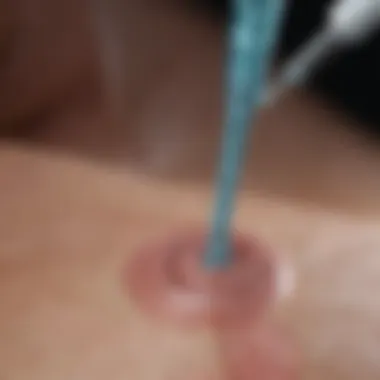Essential Guide to Intermittent Catheter Use


Intro
The use of intermittent catheters serves an important role in managing urinary conditions. Many individuals, due to medical issues, require assistance in emptying their bladders effectively. This guide aims to clarify how and when to use these devices, making the process easier for both the healthcare providers and the patients themselves.
Overview of Research Topic
Brief Background and Context
Intermittent catheterization has existed in various forms for centuries. Developments in materials and design have greatly improved their safety and effectiveness. These catheters allow for bladder management, reducing the risk of urinary retention and promoting independence among patients. Conditions like spinal cord injuries, multiple sclerosis, or post-surgical recovery often necessitate the use of intermittent catheters for optimal urinary function.
Importance in Current Scientific Landscape
The advancement of intermittent catheters is significant in contemporary medical practice. Improved designs and materials have increased their comfort and reduced risks. There is increasing focus on patient-centered approaches in healthcare, and understanding catheter use is crucial for healthcare professionals. This understanding contributes to better patient education and outcomes.
Methodology
Research Design and Approach
This article synthesizes existing research and clinical guidelines concerning intermittent catheter use. It reviews various studies and recommendations from reputable medical organizations to compile best practices.
Data Collection Techniques
The data presented in this guide stems from peer-reviewed research, clinical guidelines, and expert opinions within the field. Additionally, understanding patient testimonials and experiences adds depth to the analysis, offering valuable insights into practical applications.
Current best practices emphasize the importance of education and training for both patients and caregivers when using intermittent catheters.
Understanding Intermittent Catheterization
Intermittent catheterization is a medical procedure that involves the temporary insertion of a catheter into the bladder to drain urine. Understanding this practice is crucial for individuals who may need to use catheters on a regular basis due to various medical conditions. This section aims to lay the groundwork for a thorough understanding of what intermittent catheterization is, its historical context, and its significance in modern healthcare.
Among the primary benefits of learning about intermittent catheterization are improved management of urinary retention and prevention of potential complications associated with urinary tract conditions. For patients dealing with circumstances that hinder natural urination, intermittent catheters can provide a more comfortable and controlled way to manage their urinary output.
Also, it is important to consider the hygiene practices that must be adhered to during catheterization. Ensuring that the procedure is performed in a sterile manner can significantly reduce the risk of infections, which are common complications associated with catheter use.
Overall, understanding intermittent catheterization helps empower patients and caregivers alike with the knowledge necessary to manage their condition appropriately.
Definition of Intermittent Catheterization
Intermittent catheterization is defined as the process of periodically inserting a catheter to empty the bladder. Unlike indwelling catheters, which are left in the bladder continuously, intermittent catheters are inserted, used, and then removed. This method allows for more natural bladder function and reduces the risk of complications associated with long-term catheter use. The procedure can be performed by trained healthcare providers or by patients themselves, depending on their capability and condition.
History and Development of Catheterization Techniques
The practice of catheterization dates back thousands of years. Early records show that ancient civilizations utilized various materials to create primitive forms of catheters. However, significant advancements in catheter design and materials have occurred over time, greatly enhancing patient comfort and safety.
In the mid-20th century, advancements in materials such as latex, silicone, and hydrophilic coatings revolutionized the practice. These innovations led to the creation of catheters that are more biocompatible and user-friendly. The evolution of catheterization techniques has also been influenced by growing awareness of the importance of hygiene practices, underlining the role of education in improving patient outcomes.
As the understanding of urinary health and hygiene has expanded, so too has the development of catheterization techniques, making this procedure a well-accepted practice in both clinical and home settings.
Indications for Using Intermittent Catheters
Understanding the indications for using intermittent catheters is crucial for effective urinary management. Intermittent catheterization serves a specific purpose, targeting several medical conditions and postoperative care needs. This section will clarify the contexts in which catheterization becomes necessary. It emphasizes the importance of recognizing the right situation for catheter use to enhance patient care and avoid unnecessary complications.
Medical Conditions Requiring Catheterization
Intermittent catheters are often utilized in various medical conditions that lead to urinary retention or obstruction. Conditions such as multiple sclerosis, spinal cord injuries, and stroke can impair bladder control. These conditions can prevent patients from emptying their bladders naturally, leading to potential complications, like urinary tract infections or bladder damage.
In these cases, caregivers and healthcare professionals must evaluate the need for catheterization based on the individual’s specific medical history and current health status. Moreover, it is essential to consider the frequency of catheterization based on the underlying condition. For example, patients suffering from neurogenic bladder often require more regular catheterization to maintain urinary health.
Here are some common conditions that may necessitate catheter use:
- Neurological disorders (e.g., Parkinson's disease)
- Congenital abnormalities of the urinary tract
- Prostate issues leading to urinary retention
- Post-traumatic conditions affecting the bladder


"Choosing the right indication for catheter use can significantly impact patient comfort and health outcomes."
Post-Surgical Use of Intermittent Catheters
Following certain surgical procedures, patients might experience temporary urinary retention. In these cases, using intermittent catheters can assist in effective urinary management. Surgical interventions, particularly those related to the pelvic region, may compromise bladder function either temporarily or longer. Such procedures could include prostatectomy, hysterectomy, or bladder surgery.
In post-surgical scenarios, intermittent catheters help ensure proper bladder emptying and reduce the risk of retention and infection. The timing of catheterization after surgery is vital. Healthcare providers should assess when it is appropriate to commence catheterization depending on the patient’s recovery and individual needs.
Key Considerations
- Evaluate the underlying medical conditions and their impact on urinary management.
- Assess the risks and benefits of catheterization in post-surgical care.
- Adjust catheter use based on patient tolerance and health progression.
In summary, knowing when to use intermittent catheters is essential in various medical conditions and post-surgical care. Adapting to patient needs will promote better outcomes and ensure effective management of urinary function.
Types of Intermittent Catheters
The choice of intermittent catheter is crucial for achieving optimal outcomes in urinary management. Various types of catheters exist, each designed with specific materials, sizes, and systems for diverse medical needs. Understanding these nuances not only enhances patient comfort but also minimizes the risk of complications associated with their use. Thus, it is vital to discuss the distinct categories of intermittent catheters, as their proper selection and use can significantly influence the effectiveness of the catheterization process.
Material Composition: Latex vs. Silicone
When choosing an intermittent catheter, the material composition plays a fundamental role in determining its suitability for a patient. The two primary materials are latex and silicone, each offering distinct characteristics.
- Latex: This material is known for its flexibility and strength. However, many patients may have latex allergies, which can provoke adverse reactions. Therefore, it is important for health professionals to ascertain the allergy status of individuals before recommending latex catheters.
- Silicone: Unlike latex, silicone catheters are hypoallergenic, making them safer for people with latex sensitivities. Silicone is also more biocompatible, which can lead to a lower risk of infections and irritation during use. Moreover, silicone catheters tend to maintain their shape better over time, offering a consistent experience for users.
Selecting between latex and silicone involves a careful assessment of allergies and personal comfort. Understanding these options ensures that patients can make informed decisions regarding their urinary management.
Different Sizes and Lengths for Various Needs
Catheters are available in multiple sizes and lengths, addressing the diverse needs of individual patients based on anatomical variance and personal preferences.
- Sizes: Catheters are typically sized based on the French scale. A larger size (higher French number) indicates a thicker catheter. Healthcare providers must choose an appropriate size to balance ease of insertion with minimizing trauma to the urethra.
- Lengths: Catheters come in various lengths: standard, pediatric, and long. Standard lengths are primarily used in adults, while pediatric versions cater to younger patients. Length can impact ease of use and patient comfort; hence, determining the right length can contribute significantly to the success of catheterization.
By selecting the right size and length, medical professionals can enhance the catheterization experience, improving compliance and minimizing discomfort.
Closed System vs. Open System Catheters
The choice between closed and open system catheters can greatly affect sterility and risk of urinary tract infections (UTIs). Each system has its intended use and considerations:
- Closed System Catheters: These are pre-lubricated catheters that come with a drainage bag. The design allows for minimal exposure to external contaminants, significantly reducing the risk of infections. Closed systems are particularly beneficial for patients with a history of UTIs or those requiring more frequent catheterization.
- Open System Catheters: This traditional approach involves lubricating the catheter manually at the time of use. While more cost-effective and simpler to use in resource-limited settings, open systems lack the protective features of closed systems, making them more susceptible to contamination.
Choosing the appropriate system of catheterization is essential in managing patient health effectively, as it helps balance ease of use with the risk of complications.
It is important to consult healthcare professionals to determine the best type of catheter based on individual needs and medical history.
Preparing for Intermittent Catheterization
Preparing for intermittent catheterization is a crucial step that can greatly influence the success and safety of the procedure. It involves not only gathering the right supplies but also understanding the principles of sterility and hygiene that are vital in preventing any potential complications. This guide emphasizes the need for meticulous preparation to ensure patients can self-catheterize with confidence and efficacy.
Gathering Necessary Supplies
Before proceeding with intermittent catheterization, it is important to gather all necessary supplies. Having everything ready at hand reduces anxiety and enhances the ease of the process. Key supplies include:
- Intermittent Catheter: Choose the appropriate size and type based on your specific needs.
- Lubricant: A sterile, water-soluble lubricant is essential for minimizing friction during insertion.
- Gloves: Non-sterile gloves help maintain hygiene and protect both the patient and the caregiver.
- Antiseptic Wipes: These are used to clean the urethral opening to reduce the risk of infection.
- Collection Container: This is necessary for the urine to ensure cleanliness and make the process more hygienic.
- Waste Disposal Bag: Used for the safe disposal of used catheters and other items.
By ensuring that all supplies are pre-assembled, one can streamline the process and focus on the technique rather than scrambling to find missing items.
Understanding Sterility and Hygiene Principles
The principles of sterility and hygiene are paramount in intermittent catheterization. Proper hygiene not only enhances patient comfort but also effectively reduces the likelihood of urinary tract infections (UTIs) and other complications. It is important to adhere to the following practices:
- Hand Hygiene: Before the procedure, wash hands thoroughly with soap and water or use an alcohol-based hand sanitizer. This serves as the first line of defense against infection.
- Catheter Sterilization: Always use a sterile, single-use catheter. Reusing catheters can introduce bacteria into the urinary tract, increasing the risk of infection.
- Clean Technique: While home catheterization may not always be done in a sterile environment, maintaining a clean technique is critical. This includes using antiseptic wipes on the urethral area and wearing gloves during the procedure.
- Disposal of Materials: Proper disposal of catheters and used materials should follow local guidelines to prevent contamination and environmental risk.


Maintaining rigorous standards of hygiene not only protects the patient but also reinforces the effectiveness of intermittent catheterization.
In summary, meticulous preparation for intermittent catheterization includes gathering essential supplies and adhering to strict hygiene protocols. This ensures a safer, more comfortable experience that maximizes the effectiveness of the procedure.
Step-by-Step Guide to Self-Catheterization
Self-catheterization can seem daunting. However, mastering this skill is vital for individuals who require catheterization to manage their urinary health. This step-by-step guide aims to break down the process into manageable parts, instilling confidence in patients and ensuring optimal outcomes. By following each step carefully, users can minimize risks and enhance their comfort.
Initial Preparations and Positioning
Before starting, proper preparation is crucial. Gathering all necessary supplies ahead of time prevents interruptions and promotes smooth execution. Here are some key items needed:
- Intermittent Catheter: Choose the right type and size.
- Lubrication Jelly: Ensure this is sterile to maintain hygiene.
- Gloves: Wear disposable gloves for added protection.
- Antiseptic Wipes: Clean the area effectively before insertion.
Once all items are collected, find a comfortable and private location. Positioning is important. Ideally, users should sit or lie down in a way that provides access to the urethral area. Women can sit on the toilet or put one foot up on a surface, while men may prefer standing or sitting as well.
Insertion Techniques for Optimal Outcomes
Insertion technique is key for reducing discomfort and risk of infection. Begin by washing hands thoroughly, then put on gloves. Use antiseptic wipes to clean the urethral meatus, which is the opening of the urethra. This step is essential to maintain a sterile environment.
To insert the catheter, adopt a familiar grip. Apply lubrication generously on the catheter tip to ease the process. For women, gently separate the labia while slowly advancing the catheter into the urethra. For men, hold the shaft of the penis while inserting the catheter carefully. Once the catheter is in place, urine should start to flow. Do not force it if resistance is met; adjust the angle slightly.
Removing the Catheter: Best Practices
Upon completing the catheterization, proper removal is just as important. First, ensure the bladder is empty. Slowly withdraw the catheter while maintaining control to avoid any mishaps. It is advised to use a gentle and steady motion. After removal, dispose of the catheter according to local guidelines. If using a reusable catheter, it should be cleaned following the manufacturer's instructions.
Post-Catheterization Care and Disposal
After successfully removing the catheter, post-catheterization care helps prevent infections. Washing hands again is critical. Clean the genital area with mild soap and water. Use clean towels to pat dry if needed. If any straps or adhesive dressings were used, they should be replaced or repositioned as necessary.
Disposing of the catheter properly is vital. If using a single-use catheter, place it in a sealed bag before throwing it in the trash. For reusable catheters, adhere to cleaning and storage directions to ensure safety and longevity. Regularly inspecting for any signs of damage is also recommended.
Proper hygiene and care can significantly reduce the risk of complications associated with catheterization.
A thorough understanding of the step-by-step process of self-catheterization aids in better management of urinary health. Mastering these steps can greatly enhance the quality of life for individuals relying on intermittent catheters.
Potential Complications and Management
Understanding Potential Complications and Management in intermittent catheterization is vital. The process of using catheters presents certain risks that can affect the individual’s health and comfort. Proper management and awareness of potential complications can minimize these risks, improving the overall experience for users. Recognizing and addressing complications promptly leads to better outcomes and enhances patient quality of life.
Common Risks Associated with Catheterization
Several risks are linked with intermittent catheterization. Knowing these risks is crucial for anyone undergoing this procedure:
- Urinary Tract Infections (UTIs): One of the most frequently encountered risks is the development of UTIs, which can lead to serious health complications if not treated.
- Bladder and Urethral Injury: Improper insertion techniques can cause injury to the bladder or urethra.
- Catheter Blockage or Leakage: Blockages can occur when the catheter is not adequately cleaned or when debris accumulates.
- Inflammation and Irritation: Some individuals may experience irritation or inflammation around the urinary tract, often due to the material of the catheter.
Signs and Symptoms of Complications
Being aware of the signs and symptoms of complications can empower users to seek timely medical attention. Some common indicators include:
- Fever or Chills: These can signal an infection.
- Pain or Discomfort: Persistent pain in the abdomen or bladder may indicate a more serious issue.
- Change in Urine Color or Smell: A strong odor or an unusual color can be a sign of a UTI.
- Difficulty in Urination: Any significant difficulty or discomfort while urinating should be addressed immediately.
"Early recognition of symptoms is crucial for effective management and treatment of complications."
Mitigation Strategies to Reduce Risks
Implementing strategies to mitigate risks associated with catheterization can lead to safer practices:
- Adhere to Hygiene Practices: Maintaining strict hygiene reduces the risk of infections. Always wash hands thoroughly before and after catheterization.
- Proper Insertion Techniques: Educating oneself on the correct methods can prevent injuries related to catheter insertion.
- Regular Monitoring: Keeping track of any signs of complications can help manage any issues before they escalate.
- Hydration: Staying well-hydrated may help flush out the urinary tract, potentially reducing infection risk.
In summation, an understanding of potential complications, awareness of their signs, and implementation of effective management strategies are essential for anyone using intermittent catheters. By prioritizing these aspects, individuals can better navigate the complexities of catheterization with confidence.


Psychosocial Aspects of Intermittent Catheterization
Intermittent catheterization is not just a technical process; it also encompasses significant psychosocial elements. The act of using intermittent catheters can heavily influence an individual’s emotional state and social interactions. Understanding these aspects is crucial for healthcare providers and caregivers to offer comprehensive support. Psychological distress can arise from feelings of shame, isolation, or a loss of autonomy. Addressing the psychosocial implications is vital for enhancing the patient experience, leading to better adherence and outcomes.
Understanding the Emotional Impact on Patients
Patients may experience a variety of emotions when faced with the necessity of intermittent catheterization. Anxiety can often stem from concerns about pain, embarrassment, or the procedural complexity. It is important to recognize that these feelings can hinder the patient’s willingness to manage their urinary health effectively. For some, the act of catheterization may evoke feelings of vulnerability.
Support strategies could include patient education about the procedure itself, which often alleviates fears related to the unknown. Furthermore, encouraging patients to express their feelings can create an open dialogue. This communication fosters trust between the patient and healthcare provider, providing emotional relief and motivating engagement in self-care.
"Feeling supported can significantly change the outlook of those managing chronic conditions like needing a catheter."
Support Systems for Individuals Using Catheters
Support systems play an essential role in assisting individuals who use intermittent catheters. These can come from both formal and informal sources. Formal support might include healthcare professionals who provide instruction and assist in managing complications. Informally, family, friends, and peer networks can make a considerable difference in a person's emotional well-being.
Some beneficial support systems might include:
- Education Programs: Workshops where individuals can learn about catheterization can help demystify the process.
- Peer Support Groups: Meeting others in similar situations can provide encouragement and reduce feelings of isolation.
- Online Communities: Sites like Reddit or Facebook groups provide platforms for discussion and shared experiences.
Connecting with others who understand the challenges can greatly ease the emotional burden of frequent catheter use. Providing an environment of understanding allows individuals to gain confidence, fostering self-efficacy in managing their condition.
Resources for Patients and Caregivers
Understanding the resources available for patients and caregivers is essential when using intermittent catheters. These resources can significantly affect the quality of life and ease of managing urinary conditions. They provide necessary information, community support, and ongoing education, helping individuals navigate the challenges associated with catheterization.
Educational Materials and Training Programs
Educational materials are vital in enlightening patients and caregivers about the use of intermittent catheters. These materials can include:
- Instructional videos: Visual aids demonstrate the catheterization process and hygiene techniques effectively.
- Brochures and pamphlets: These provide condensed, easily digestible information on types of catheters, insertion techniques, and care practices.
- Online courses: Structured programs allow users to learn at their own pace, often including assessments for comprehension.
Training programs can vary in format but generally emphasize practical applications. For instance, hands-on workshops may provide real-time guidance from healthcare professionals. Consequently, patients feel more confident in their ability to self-catheterize.
Support Groups and Online Communities
Support groups and online communities play a crucial role in creating a sense of connection among individuals using intermittent catheters. These platforms allow people to share their experiences, concerns, and strategies. Some benefits include:
- Peer support: Interactions with others who face similar challenges can provide emotional relief and encouragement.
- Access to shared knowledge: Community members often share tips, personal stories, and useful resources that can help newcomers.
- 24/7 communication: Online forums enable users to ask questions and seek advice at any time, fostering a continuous support network.
Prominent platforms include Reddit, Facebook, and dedicated websites focusing on urinary health, making it easier for patients to find the information they need at any time.
"A support system is essential when dealing with medical conditions. Engaging with others can lead to improvements in both emotional well-being and practical management of health issues."
In summary, leveraging educational materials, training programs, and support networks provides patients and caregivers with the tools necessary to cope with the demands of intermittent catheterization. These resources not only enhance knowledge but also promote a community of support, fostering resilience.
Future Directions in Intermittent Catheterization
The topic of future directions in intermittent catheterization is crucial as it emphasizes ongoing improvements and innovations that can transform patient experiences and outcomes. As the medical field continuously evolves, so too do the technologies and methodologies surrounding urinary management. The importance of staying current with these advancements cannot be overstated. With many patients requiring catheter use for various medical conditions, the enhancements in design, functionality, and usability can significantly improve their quality of life.
Technological Advances in Catheter Design
Recent years have seen remarkable technological changes in catheter design. Manufacturers are focusing on materials that enhance comfort and reduce risk of infection. For instance, hydrophilic coatings are becoming more common, as they allow catheters to become slippery when hydrated, minimizing friction during insertion. This innovation can specially benefit patients who perform self-catheterization.
Furthermore, smart catheters are starting to emerge. These devices are equipped with sensors that monitor bladder pressure and urine output. This data can be invaluable for both patients and healthcare professionals, offering real-time feedback and adjustments to the catheterization schedule. Additionally, user-friendly designs that simplify the process for patients of all ages are currently under development.
Innovations in sizes and lengths of catheters are also prevalent. Customization options help meet the unique needs of each patient, addressing factors such as anatomical differences and personal comfort.
Research Trends in Urinary Management
The research trends in urinary management focus on improving patient outcomes through clinical studies and trials. Ongoing investigations into the long-term effects of intermittent catheterization are vital for understanding its implications on kidney health and urinary function. Researchers are looking at how various catheter materials influence infection rates and patient comfort.
Additionally, studies aiming to evaluate psychosexual aspects related to catheter use are increasing. Researchers aim to address not only the physical but also the emotional burdens carried by patients. Such investigations can aid in developing supportive resources that help patients cope better with self-catheterization.
Moreover, interdisciplinary approaches involving urologists, nurses, and biomedical engineers are becoming more common. Collaboration across these fields can lead to innovative solutions tailored to patient needs, ultimately improving adherence and satisfaction with the catheterization process.
"Innovation in catheter technology and research is not just about improved materials; it is about revolutionizing the way we approach urinary health management."



